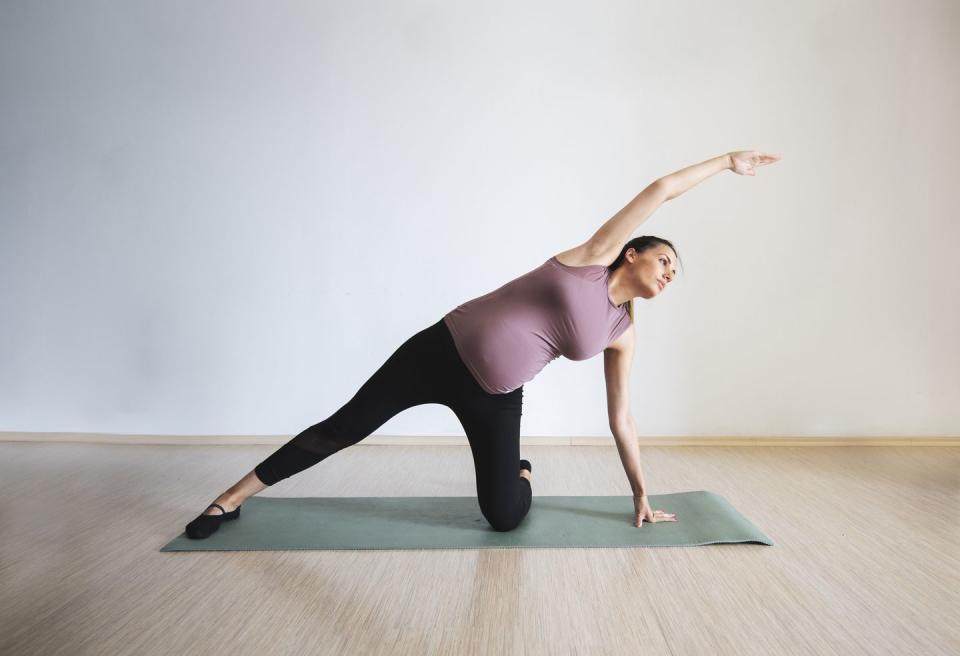Why pregnant women should practise yoga

It’s important to keep fit and healthy while you’re expecting, and pregnancy yoga can be the perfect solution. By focusing on the balance between your mind, body and breath, this centuries-old practice helps to relieve stress and tension, increase strength and flexibility, and address common prenatal symptoms like lower back pain and nausea.
You don’t have to be an experienced yogi to reap the benefits of pregnancy yoga. The postures for beginners are simple, and suit any fitness level. Best of all, you’ll meet other mums-to-be at your classes.
But don’t just take our word for it – here, we speak to midwife Manijeh Nedas and antenatal yoga teacher Andrea Fox about the various benefits of pregnancy yoga:
What is pregnancy yoga?
Also called prenatal yoga, pregnancy yoga typically involves breathing exercises, gentle stretching, simple postures, and potentially a short meditation at the end. Some of the postures will be the same as in a normal yoga class, but many others will be modified specially for pregnancy. You will also learn relaxation techniques to use during labour, as well as positions that may help to ease the pain of contractions.
7 benefits of pregnancy yoga
There are a number of benefits associated with establishing a pregnancy yoga routine, from birth to post-delivery stages:
1. Pregnancy yoga boosts flexibility
‘Generally, pregnant mums who do yoga exercises appear healthier in mind and body,’ says Nedas. ‘Their bodies are more flexible, which enables them to adapt to various positions when in labour and the ligaments are more elastic, which in turn can help to reduce labour pain.’
2. Pregnancy yoga boosts circulation
Bending, stretching and lengthening the body boosts circulation and also helps with fluid retention, according to Fox.
3. Pregnancy yoga eases stress
Yoga is known for its ability to ease stress and promote relaxation, and pregnancy yoga is no different. The calmer you feel during pregnancy, the better it is for your health and the health of the baby.
4. Pregnancy yoga improves posture
Yoga stretches and lengthens the spine and opens your shoulders, improving your posture. This can help ease back problems, which are common in pregnant women.
5. Pregnancy yoga helps prepare for birth
‘Yoga helps to prepare for the birth – it encourages breath and body awareness, reduces worry and teaches women to adapt to new situations,’ adds Fox.
6. Pregnancy yoga improves your sleep
Pregnant women often have trouble falling and staying asleep, but a regular practice can improve the quality and duration of your sleep.
7. Pregnancy yoga strengthens muscles
Yoga continues to have benefits after pregnancy, too. Postnatal yoga, which can be started about six weeks after the birth, strengthens abdominal muscles and your pelvic floor.
How to start pregnancy yoga
If you’re new to yoga, start by taking classes to learn the poses under supervision. It’s best to start during the second trimester, after around 14 weeks, since most miscarriages occur during the first trimester. There’s no evidence that practising yoga in the first trimester will harm your baby, but most instructors will err on the side of caution.
For those who already attend a regular yoga class, be sure to tell your teacher that you’re pregnant, and ask them whether they’re trained to instruct pregnant women. If so, they’ll be able to help you modify postures in your usual practice. You can also practice at home, but take care to stick to the modifications you’ve been given.

Generally, prenatal yoga classes, hatha yoga classes and restorative yoga classes are the best choices for pregnant women. Avoid power yoga styles, such as ashtanga, which are vigorous in nature, as well as bikram or ‘hot’ yoga, which takes place in a hot room. This can be dangerous during pregnancy.
Always consult your doctor or midwife before starting a pregnancy yoga class or routine to make sure it’s suitable for you. If you’re at an increased risk of preterm birth or have certain medical condition – for example, heart disease or back problems – they may advise against it.
Is pregnancy yoga safe?
Yoga during pregnancy is safe – however, pain or nausea should not be felt at any point during or after yoga. If this happens, stop exercising and contact your GP or midwife.
Follow our tips to protect your health and the health of your baby during pregnancy yoga:
Keep it simple
Any position which feels uncomfortable should be left out, Fox says. ‘Lying on the front soon becomes inappropriate,’ she says. ‘Strong back bends are to be avoided, as are postures that involve using the tummy muscles strongly, such as the boat pose, or supine leg rising. Any posture involving balance should be tackled with great care.’
Take it easy
Mums-to-be should pay attention not to overstretch the body – the ligaments around the joints become loose and soft during pregnancy. The abdomen should stay relaxed at all times so you can use the gluteus muscles instead. Stay in your comfort zone and use the class to open, relax and stretch, without overexertion or overheating.
Pace yourself
The NHS recommends that pregnant women aim for at least 150 minutes of moderate-intensity physical activity each week (equivalent to 30 minutes, five days per week). However, if you can’t hold a conversation while practicing pregnancy yoga, you’re pushing yourself too hard.
Last updated: 15-10-20
You Might Also Like

